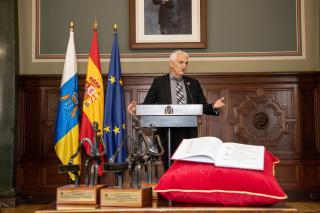It may interest you
-
 The Instituto de Astrofísica de Canarias (IAC) is demonstrating the quality and international relevance of the Canary Islands Observatories at the 245th session of the American Astronomical Society (AAS) meeting being held this week in Maryland (USA). This meeting, led by the American astrophysics community, brings together the world's most important research centres in this field to share lines of work and proposals for the present and the future. The IAC delegation in Maryland is headed by the director of the centre, Valentín Martínez Pillet, who is part of the panel of speakers with aAdvertised on
The Instituto de Astrofísica de Canarias (IAC) is demonstrating the quality and international relevance of the Canary Islands Observatories at the 245th session of the American Astronomical Society (AAS) meeting being held this week in Maryland (USA). This meeting, led by the American astrophysics community, brings together the world's most important research centres in this field to share lines of work and proposals for the present and the future. The IAC delegation in Maryland is headed by the director of the centre, Valentín Martínez Pillet, who is part of the panel of speakers with aAdvertised on -
 An international scientific team, including members of the Instituto de Astrofísica de Canarias (IAC), has launched an ambitious program to map exoplanets located around the Neptunian Desert —a region around stars where planets the size of Neptune are very rare— in order to better understand the mechanisms of planetary system evolution and formation. This scientific expedition has delivered its first results with the observation of the TOI-421 planetary system. Analysis of this system reveals a surprisingly inclined orbital architecture, offering new insights into the chaotic history ofAdvertised on
An international scientific team, including members of the Instituto de Astrofísica de Canarias (IAC), has launched an ambitious program to map exoplanets located around the Neptunian Desert —a region around stars where planets the size of Neptune are very rare— in order to better understand the mechanisms of planetary system evolution and formation. This scientific expedition has delivered its first results with the observation of the TOI-421 planetary system. Analysis of this system reveals a surprisingly inclined orbital architecture, offering new insights into the chaotic history ofAdvertised on -
 El Instituto de Astrofísica de Canarias (IAC) ha sido distinguido por la Delegación del Gobierno en Canarias con uno de los reconocimientos entregados durante el acto de conmemoración del 47 aniversario de la Constitución española de 1978, celebrado este 6 de diciembre y presidido por el delegado del Gobierno en Canarias, Anselmo Pestana. La Delegación del Gobierno ha reconocido la labor del IAC, que celebra su 40 aniversario, en virtud del artículo 44.2 de la Constitución Española, por su fundamental contribución a la promoción de la ciencia y la investigación científica y técnica enAdvertised on
El Instituto de Astrofísica de Canarias (IAC) ha sido distinguido por la Delegación del Gobierno en Canarias con uno de los reconocimientos entregados durante el acto de conmemoración del 47 aniversario de la Constitución española de 1978, celebrado este 6 de diciembre y presidido por el delegado del Gobierno en Canarias, Anselmo Pestana. La Delegación del Gobierno ha reconocido la labor del IAC, que celebra su 40 aniversario, en virtud del artículo 44.2 de la Constitución Española, por su fundamental contribución a la promoción de la ciencia y la investigación científica y técnica enAdvertised on
